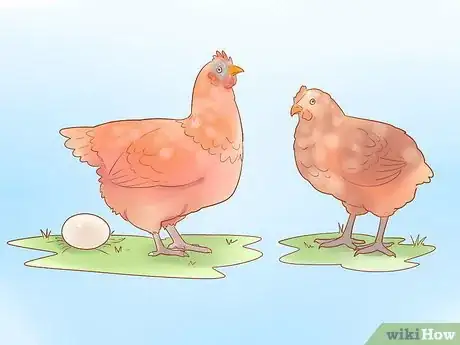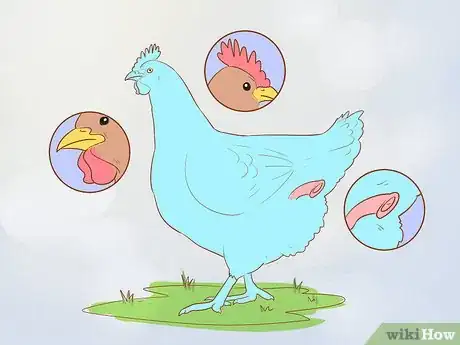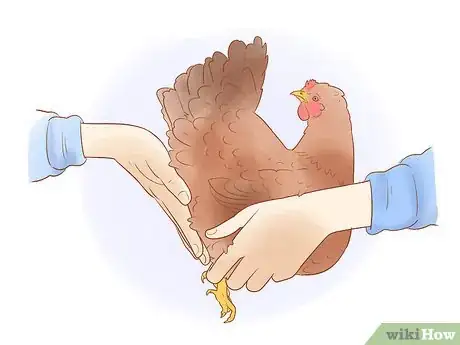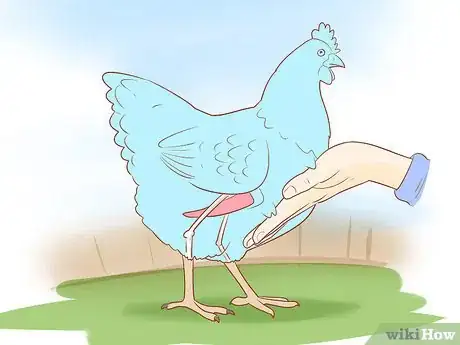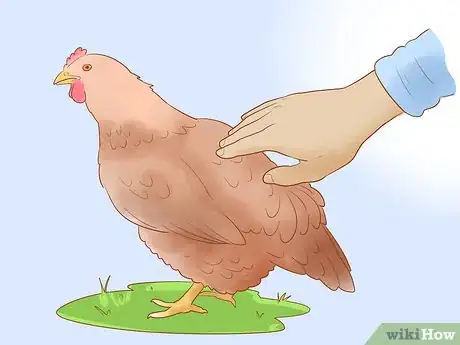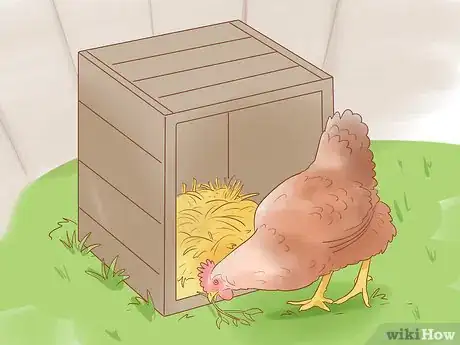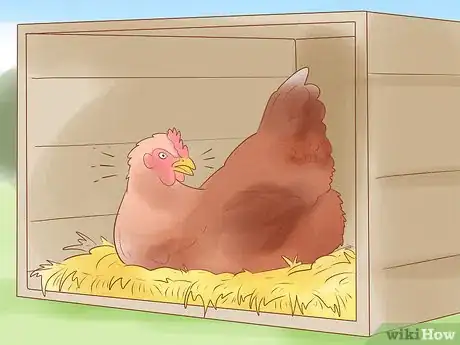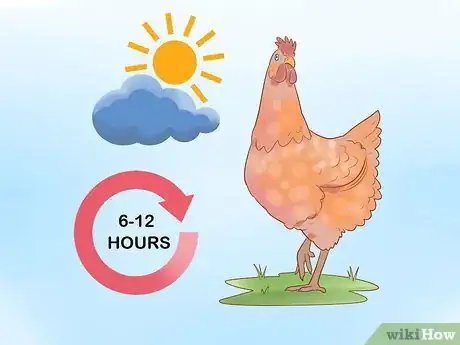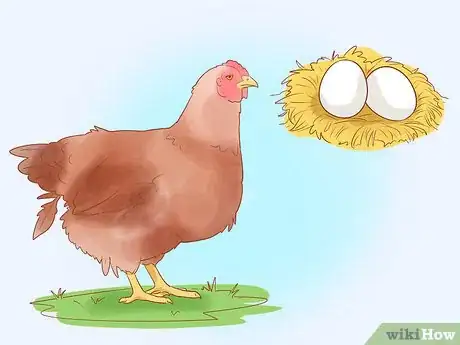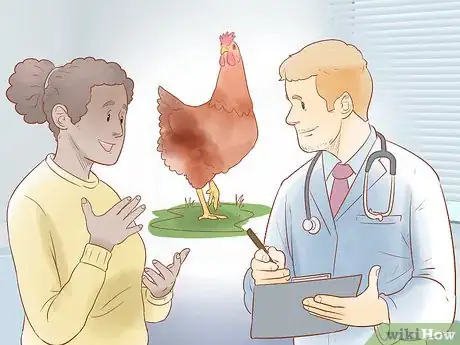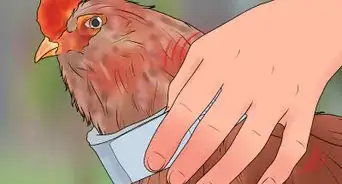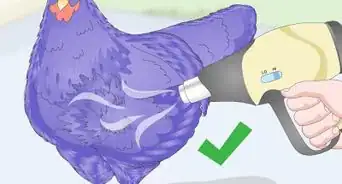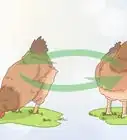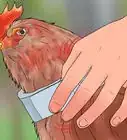This article was co-authored by Ryan Corrigan, LVT, VTS-EVN and by wikiHow staff writer, Christopher M. Osborne, PhD. Ryan Corrigan is a Licensed Veterinary Technician in California. She received her Bachelor of Science in Veterinary Technology from Purdue University in 2010. She is also a Member of the Academy of Equine Veterinary Nursing Technicians since 2011.
This article has been viewed 99,949 times.
Once a properly cared-for hen starts laying eggs, it will continue to do so consistently every 24-27 hours (so long as it’s getting enough light). To predict when a hen will lay its first egg, check for physical signs of maturity, as well as behavioral changes that indicate the bird is ready to lay. If the hen stops laying eggs, look for signs that it has moved out of its egg-laying years, then check for evidence of malnutrition or illness.
Steps
Checking for Physical Signs
-
1Consider the hen’s age along with an “adult” appearance. The age at which hens start to lay eggs varies widely depending on their breed—some start as early as 16 weeks, while others begin at around 16 months. Whether you know the typical laying age of your hen’s breed or not, it’s always helpful to ask yourself if the hen looks like an adult.[1]
- If you have other adult hens, compare the size, bone structure, and fullness of appearance. A hen that takes on a more mature appearance is usually ready to lay.[2]
- You may notice a rapid increase in size and weight, especially in the abdominal area, when a hen is ready to lay.
-
2Watch for the comb, wattles, and vent to get larger and redder. An immature hen will have a small, dull-colored comb (on top of its head) and wattles (under its beak). When the hen reaches laying age, the comb and wattles will grow in size and take on a deep red color.[3]
- Likewise, the vent—the opening from which the hen releases eggs, along with urine and feces—will get larger and redder. It will also likely go from being dry to moist.
Advertisement -
3Check if the hen’s pelvic bones have separated. Pick up the bird, cradle it against your side with your arm so the tail end is facing forward, and use your hand to hold its feet. With your free hand, feel the hen's rear end. If you can't feel 3 distinct bones with spacing between them, the bird isn't ready to lay yet.[4]
- If the spacing between the 3 bones is as wide as 3 of your fingers, the hen is probably ready to start laying.[5]
-
4Look for growth between the pelvic bones and the breastbone. In addition to the growing space between the pelvic bones, the gap between a hen’s pelvic and keel bones (at the base of the breastbone) will increase when it’s ready to start laying. You may be able to notice the greater separation visually, and will definitely be able to feel it if you pick the bird up.[6]
- The abdominal area between the pelvic bones and breastbone will probably also become larger and softer (due to increased fat buildup).
Observing Behavioral Changes
-
1Take note of “squatting” behavior that signifies mating readiness. Place your hand right over the hen’s back, without actually touching it. If the hen squats down—with its back pressed downward and its wings and legs spread out a bit more—it’s ready to start laying eggs.[7]
- Hens assume this “squatting” position when mating with a rooster. But they’ll also do it when they’re ready to lay eggs, even if there aren’t any roosters around.
- You only need a rooster around if you intend to breed chickens. Hens will lay unfertilized eggs without a rooster present.
-
2Watch for the hen to start preparing its nesting area. If you’ve built a nesting box for your hen, it will start hanging around the box more and begin rearranging the bedding material (straw, wood shavings, etc.) to its liking when it’s ready to lay. If you are raising chickens completely free-range, watch for a hen to identify an isolated spot and start digging and collecting materials to create its own nesting area.[8]
- You can build nesting boxes out of a wide range of materials, such as old wooden drawers. They should be 12 × 12 × 12 in (30 × 30 × 30 cm) or a bit larger in size. You don’t necessarily have to provide a box for each hen, but you should create at least 1 box for every 2-3 hens.
-
3Get ready for the first egg when it perches on its nest. When a hen is ready to lay its first egg, it will perch on top of the nest it has set up in its chosen nesting box (or nesting area). You may notice it straining from time to time, and it might make some crowing or cackling sounds. Within about a day, you’re likely to find an egg in the nest![9]
- This first egg, and perhaps several more to follow, may be small or misshapen. The size and shape will grow more consistent over time.
- Once a hen starts laying eggs, it will create a new one every 24-27 hours during its laying season.
- If the hen has not produced an egg after sitting on the nest for 2-3 days, call a veterinarian. The hen may be “egg bound” and will need medical attention.
Determining Why a Hen Isn’t Laying
-
1Figure out if the hen is getting 12-16 hours of light per day. In nature, hens stop laying eggs when they get less than about 12 hours of daylight per day. They’ll start up again when they receive 12+ hours of light daily, and produce an egg every 24-27 hours.[10]
- If you’re going for a more natural approach, just wait a few months for the days to get longer, and your hen will start laying again. Depending on the seasonal changes in daylight where you live, hens often take a 3-4 month break.
- You can keep your hens laying eggs year-round by supplementing daylight with artificial light. Adding just a 60-watt incandescent bulb (or equivalent) to the coop may be sufficient to keep the hens laying. Use a timer to provide 14-16 hours of light—the light doesn’t need to be on during daylight.
-
2Don’t expect eggs after a hen reaches 3-4 years of age. Hens can live for 5-10 years, but after about 3-4 years their egg production will taper off and stop. As the time approaches, the eggs will become less and less frequent, and may also be smaller or misshapen.[11]
- Some people decide to use hens for meat at this point, but you can also choose to keep them around—hens tend to become more docile and friendly as they age.
-
3Look for physical signs that the hen is done laying for good. When the hen reaches the end of its egg-laying years, its comb and wattles will fade from their deep red coloring. Likewise, the vent will fade in color and become smaller and less moist. Additionally, the spacing between the pubic bones and breastbone, as well as between the pubic bones, will decrease.[12]
- Essentially, the hen will return to its appearance before it started laying eggs.
- The hen will likely also stop its nesting and “squatting” behaviors.
-
4Evaluate whether a laying-age hen is well-fed and healthy. If your hen is in the right age range, shows physical and behavioral signs of laying, and is getting enough daylight, it should be laying eggs. If it isn’t, investigate possible causes and consult your vet as needed. Common problems include:[13]
- The hen doesn’t have access to clean, fresh water at all times. Check your watering system for problems.
- The hen isn’t getting enough feed and/or adequate nutrition from its feed. Change to a higher-quality feed and consult your vet for feeding advice.
- The hen has parasites or an illness. Sick hens lay fewer eggs and may stop altogether. Get in touch with your vet.
Warnings
- If her first egg is slightly misshapen, this is normal. Keep in mind the hen’s body is not used to making eggs yet.⧼thumbs_response⧽
References
- ↑ https://youtu.be/-qOa0HroROs?t=40
- ↑ https://animals.mom.me/tell-chicken-ready-lay-9921.html
- ↑ https://articles.extension.org/pages/71004/raising-chickens-for-egg-production
- ↑ https://www.nutrenaworld.com/blog/when-pullets-start-to-lay-eggs
- ↑ https://www.theselfsufficienthomeacre.com/2015/01/how-to-tell-if-a-hen-is-laying-eggs.html
- ↑ https://articles.extension.org/pages/71004/raising-chickens-for-egg-production
- ↑ https://youtu.be/-qOa0HroROs?t=210
- ↑ https://animals.mom.me/tell-chicken-ready-lay-9921.html
- ↑ https://animals.mom.me/tell-chicken-ready-lay-9921.html
- ↑ https://articles.extension.org/pages/71004/raising-chickens-for-egg-production
- ↑ https://articles.extension.org/pages/71004/raising-chickens-for-egg-production
- ↑ https://articles.extension.org/pages/71004/raising-chickens-for-egg-production
- ↑ https://articles.extension.org/pages/71004/raising-chickens-for-egg-production
About This Article
To tell if a hen is ready to lay eggs, keep an eye out for nesting behavior, like rearranging bedding material in the nesting box or digging and collecting materials to make a nest. Also, try placing your hand over the hen's back without touching it and seeing if it squats down. If it does, the hen is ready to start laying eggs. You should also watch to see if the hen perches on its nest and makes crowing or cackling sounds, which is a sign that the hen will lay an egg in about 1 day. To learn how to determine why a hen isn't laying eggs, scroll down.
